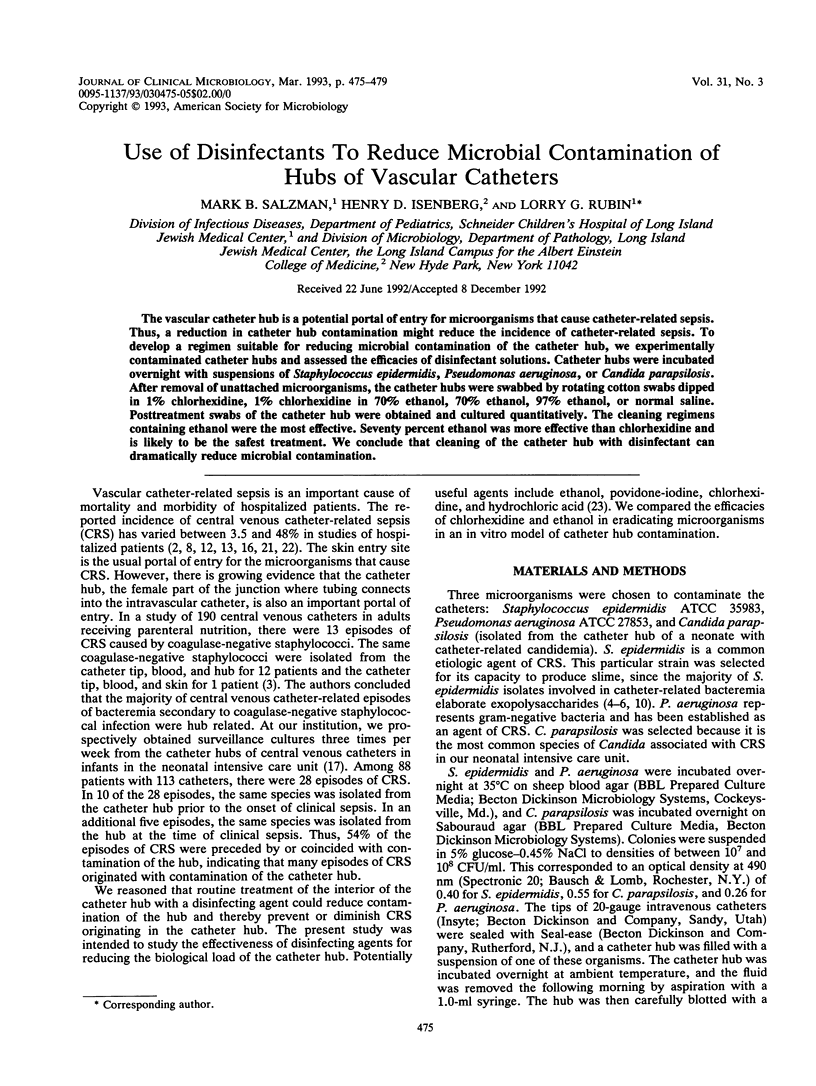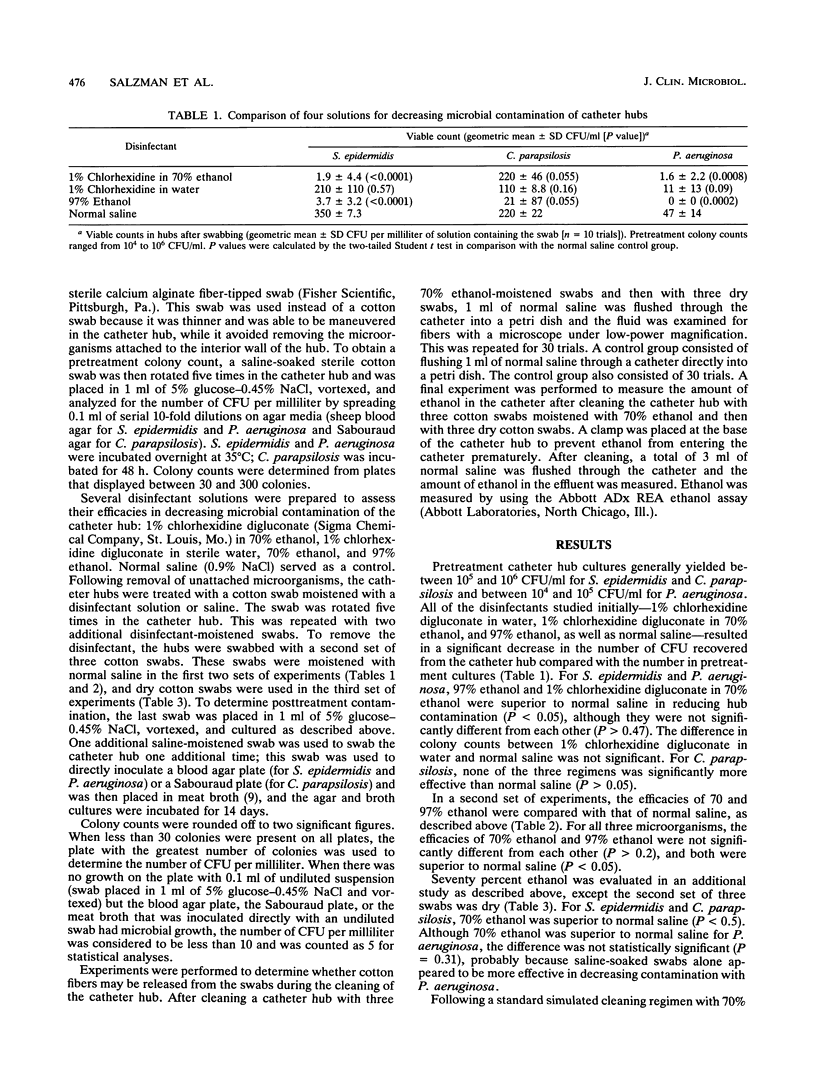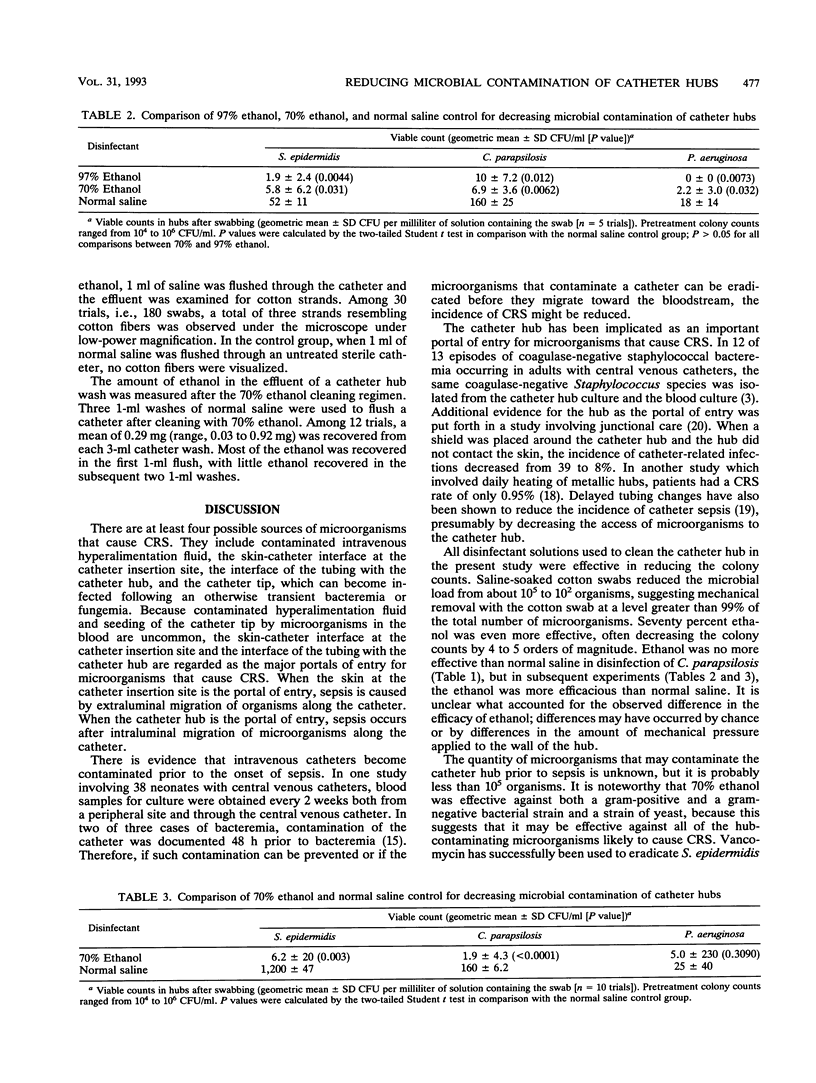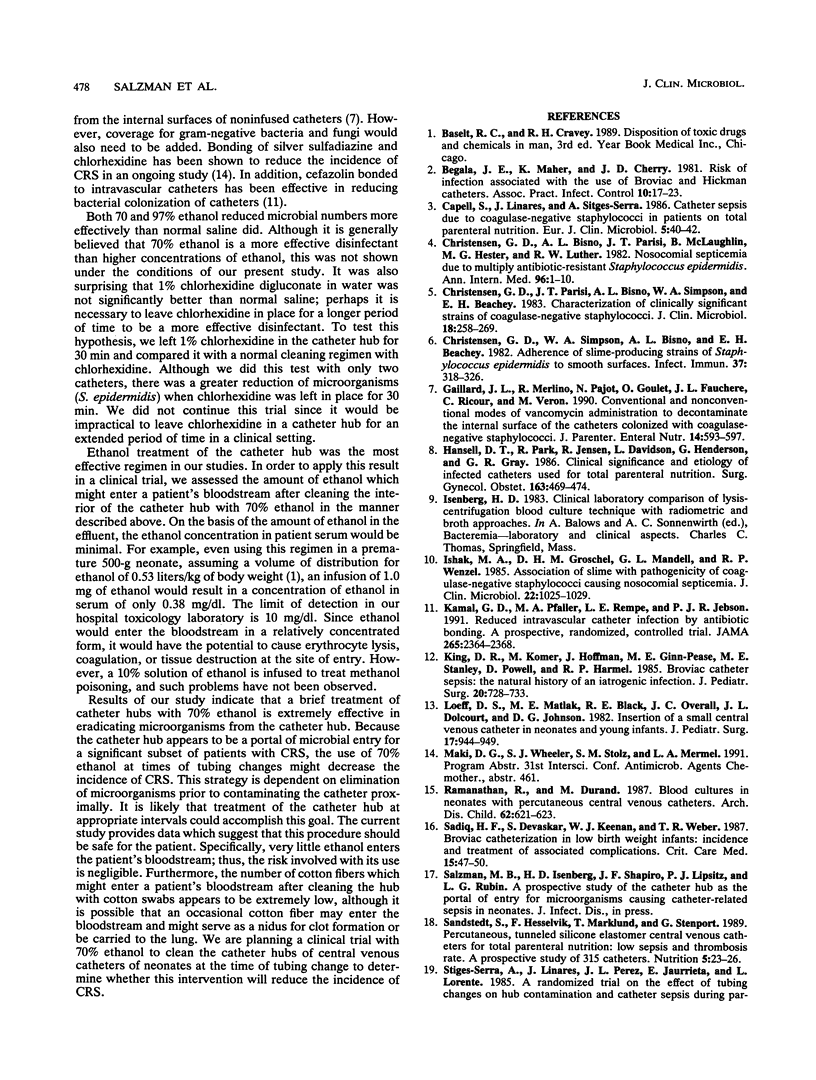Abstract
The vascular catheter hub is a potential portal of entry for microorganisms that cause catheter-related sepsis. Thus, a reduction in catheter hub contamination might reduce the incidence of catheter-related sepsis. To develop a regimen suitable for reducing microbial contamination of the catheter hub, we experimentally contaminated catheter hubs and assessed the efficacies of disinfectant solutions. Catheter hubs were incubated overnight with suspensions of Staphylococcus epidermidis, Pseudomonas aeruginosa, or Candida parapsilosis. After removal of unattached microorganisms, the catheter hubs were swabbed by rotating cotton swabs dipped in 1% chlorhexidine, 1% chlorhexidine in 70% ethanol, 70% ethanol, 97% ethanol, or normal saline. Posttreatment swabs of the catheter hub were obtained and cultured quantitatively. The cleaning regimens containing ethanol were the most effective. Seventy percent ethanol was more effective than chlorhexidine and is likely to be the safest treatment. We conclude that cleaning of the catheter hub with disinfectant can dramatically reduce microbial contamination.
Full text
PDF




Selected References
These references are in PubMed. This may not be the complete list of references from this article.
- Begala J. E., Maher K., Cherry J. D. Risk of infection associated with the use of Broviac and Hickman catheters. Am J Infect Control. 1982 Feb;10(1):17–23. doi: 10.1016/0196-6553(82)90035-9. [DOI] [PubMed] [Google Scholar]
- Capell S., Liñares J., Sitges-Serra A. Catheter sepsis due to coagulase-negative staphylococci in patients on total parenteral nutrition. Eur J Clin Microbiol. 1986 Feb;5(1):40–42. doi: 10.1007/BF02013459. [DOI] [PubMed] [Google Scholar]
- Christensen G. D., Bisno A. L., Parisi J. T., McLaughlin B., Hester M. G., Luther R. W. Nosocomial septicemia due to multiply antibiotic-resistant Staphylococcus epidermidis. Ann Intern Med. 1982 Jan;96(1):1–10. doi: 10.7326/0003-4819-96-1-1. [DOI] [PubMed] [Google Scholar]
- Christensen G. D., Parisi J. T., Bisno A. L., Simpson W. A., Beachey E. H. Characterization of clinically significant strains of coagulase-negative staphylococci. J Clin Microbiol. 1983 Aug;18(2):258–269. doi: 10.1128/jcm.18.2.258-269.1983. [DOI] [PMC free article] [PubMed] [Google Scholar]
- Christensen G. D., Simpson W. A., Bisno A. L., Beachey E. H. Adherence of slime-producing strains of Staphylococcus epidermidis to smooth surfaces. Infect Immun. 1982 Jul;37(1):318–326. doi: 10.1128/iai.37.1.318-326.1982. [DOI] [PMC free article] [PubMed] [Google Scholar]
- Gaillard J. L., Merlino R., Pajot N., Goulet O., Fauchere J. L., Ricour C., Veron M. Conventional and nonconventional modes of vancomycin administration to decontaminate the internal surface of catheters colonized with coagulase-negative staphylococci. JPEN J Parenter Enteral Nutr. 1990 Nov-Dec;14(6):593–597. doi: 10.1177/0148607190014006593. [DOI] [PubMed] [Google Scholar]
- Hansell D. T., Park R., Jensen R., Davidson L., Henderson G., Gray G. R. Clinical significance and etiology of infected catheters used for total parenteral nutrition. Surg Gynecol Obstet. 1986 Nov;163(5):469–474. [PubMed] [Google Scholar]
- Ishak M. A., Gröschel D. H., Mandell G. L., Wenzel R. P. Association of slime with pathogenicity of coagulase-negative staphylococci causing nosocomial septicemia. J Clin Microbiol. 1985 Dec;22(6):1025–1029. doi: 10.1128/jcm.22.6.1025-1029.1985. [DOI] [PMC free article] [PubMed] [Google Scholar]
- Kamal G. D., Pfaller M. A., Rempe L. E., Jebson P. J. Reduced intravascular catheter infection by antibiotic bonding. A prospective, randomized, controlled trial. JAMA. 1991 May 8;265(18):2364–2368. [PubMed] [Google Scholar]
- King D. R., Komer M., Hoffman J., Ginn-Pease M. E., Stanley M. E., Powell D., Harmel R. P., Jr Broviac catheter sepsis: the natural history of an iatrogenic infection. J Pediatr Surg. 1985 Dec;20(6):728–733. doi: 10.1016/s0022-3468(85)80034-8. [DOI] [PubMed] [Google Scholar]
- Loeff D. S., Matlak M. E., Black R. E., Overall J. C., Dolcourt J. L., Johnson D. G. Insertion of a small central venous catheter in neonates and young infants. J Pediatr Surg. 1982 Dec;17(6):944–949. doi: 10.1016/s0022-3468(82)80472-7. [DOI] [PubMed] [Google Scholar]
- Ramanathan R., Durand M. Blood cultures in neonates with percutaneous central venous catheters. Arch Dis Child. 1987 Jun;62(6):621–623. doi: 10.1136/adc.62.6.621. [DOI] [PMC free article] [PubMed] [Google Scholar]
- Sadiq H. F., Devaskar S., Keenan W. J., Weber T. R. Broviac catheterization in low birth weight infants: incidence and treatment of associated complications. Crit Care Med. 1987 Jan;15(1):47–50. doi: 10.1097/00003246-198701000-00011. [DOI] [PubMed] [Google Scholar]
- Sandstedt S., Hesselvik F., Marklund T., Stenport G. Percutaneous, tunneled silicone elastomer central venous catheters for total parenteral nutrition: low sepsis and thrombosis rate. A prospective study of 315 catheters. Nutrition. 1989 Jan-Feb;5(1):23–26. [PubMed] [Google Scholar]
- Sitges-Serra A., Liñares J., Pérez J. L., Jaurrieta E., Lorente L. A randomized trial on the effect of tubing changes on hub contamination and catheter sepsis during parenteral nutrition. JPEN J Parenter Enteral Nutr. 1985 May-Jun;9(3):322–325. doi: 10.1177/0148607185009003322. [DOI] [PubMed] [Google Scholar]
- Stotter A. T., Ward H., Waterfield A. H., Hilton J., Sim A. J. Junctional care: the key to prevention of catheter sepsis in intravenous feeding. JPEN J Parenter Enteral Nutr. 1987 Mar-Apr;11(2):159–162. doi: 10.1177/0148607187011002159. [DOI] [PubMed] [Google Scholar]
- Warner B. W., Gorgone P., Schilling S., Farrell M., Ghory M. J. Multiple purpose central venous access in infants less than 1,000 grams. J Pediatr Surg. 1987 Sep;22(9):820–822. doi: 10.1016/s0022-3468(87)80644-9. [DOI] [PubMed] [Google Scholar]
- Weber T. R., West K. W., Grosfeld J. L. Broviac central venous catheterization in infants and children. Am J Surg. 1983 Feb;145(2):202–204. doi: 10.1016/0002-9610(83)90062-4. [DOI] [PubMed] [Google Scholar]
- Worthley L. I. Treatment of central venous silastic catheter infections using hydrochloric acid. Anaesth Intensive Care. 1982 Nov;10(4):314–318. doi: 10.1177/0310057X8201000403. [DOI] [PubMed] [Google Scholar]


